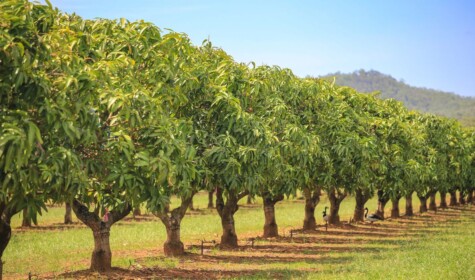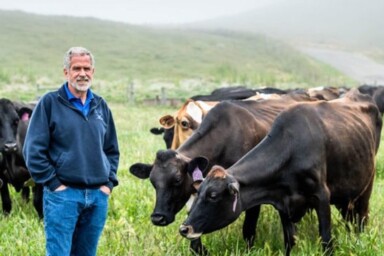Planting the ‘right trees in the right place’ is a something we hear a lot amidst discussions around post-Brexit policy and how we can achieve Britain’s targets of 17% tree cover by 2050. Planting trees on farms clearly has a big role to play in the future of Britain’s landscapes, but it’s vital to clearly think through a tree planting scheme before carrying it out. These 10 tips for planting trees on your farm will help you to make decisions that work for the short-, medium- and long-term.
Design based on your needs and constraints
1. Clarify your goals
Be clear about what you want the new trees on your farm to achieve. Clarification of goals and key requirements of trees (i.e. things new trees must achieve in order to be considered a success) is an often overlooked but vital step for appropriate tree planting. Form typically follows function. You may choose in-field alley cropping systems to provide a vital haven for biodiversity in larger fields, riparian buffers to reduce run-off into watercourses or hedgerow windbreaks planted to reduce livestock mortality and increase productivity.
2. Understand what tree species traits you need for success
Once you have understood what role you want your new trees to fulfil on the farm, it is important to understand what kinds of tree species traits will best help you to achieve your goals. It is important to list what traits you need or want from your trees to help in the selection process. For example, if you are planting trees in a silvopasture system, you may want trees that are palatable and nutritious for livestock and provide light, evenly distributed shade. If integrating trees with winter arable production, you may favour a tree species that comes into leaf late, giving your winter crop an all-important boost of sunlight in the spring.
3. Consider planting trees that fulfil an existing need or reduce a cost on your farm
The economic viability of tree planting can be increased by tying it in with existing needs on your farm. For example, short rotation coppice systems using species such as willow or poplar can produce woodchip for on-site biomass boilers, bedding for livestock or material for composting.
4. Understand how trees will affect the labour you need on your farm
Tree management often occurs at times that can otherwise be quiet on the farm. Sketching a management calendar for your current activities and proposed trees will give you a clear picture of how tree management will affect your labour requirements throughout the year. Increasing labour on the farm can even be an advantage: farming is highly seasonal and accessing labour for only short periods can be challenging. Increasing your labour requirements at otherwise calm times of year could help to support a year-round workforce.
5. Plant for a changing climate
Select species that suit future climate conditions. Climate change will alter growing conditions in the UK over the coming years. Broadly speaking, the intensity of winter storms and summer droughts will increase, as will average temperatures. Planning too far ahead (e.g. for 2080) is challenging, whereas assuming that what thrives now will thrive later is risky. A good rule of thumb when planting long-lived trees is to select those that will suit medium-term predictions in your area: such as the expected 2050 climate. Trees like drought-tolerant chestnut and frost-sensitive walnut are likely to become more suitable for areas of southern England, while some species such as beech are becoming better-suited to areas further north and west such as Scotland and Wales.
6. Consider sourcing trees that are from a climate similar to your own
While we can choose different species to suit the future climate, we can also take advantage of genetic variability within species by buying seedlings with the right provenance. Even if you have your mind set on a particular species, consider buying trees from a nursery in a place that has a similar climate to that predicted for your area. This can help the long-term adaptability of your trees and encourage adaptation of local populations. The Met Office provides up-to-date information on climate change projections to support you decision-making.
Design for management efficiency
7. Plan for management that suits the machinery and equipment on your farm
Ideally, your new tree planting should be compatible with the machinery and equipment that you already have on the farm, or that you could easily access if needed. For example, if you are planning an in-field agroforestry operation such as alley cropping, be sure that alley widths are as wide as your machinery needs to pass comfortably (or multiples of that width). If grass strips under trees need mowing, consider what mowing options are available to you without risking tree damage. Another example is if you need to apply woodchip mulch for a large number of trees. Perhaps equipment you already have, such as a muck spreader, can be repurposed for quickly distributing large quantities of woodchips.
Work with others and get support
8. Engage in partnerships with others who can help manage the trees on your farm
While you may be interested in having more trees on the farm, you may not have the capacity to manage these trees yourself. Can you partner with other parties or local producers who have the knowledge, skills and equipment? This can ensure good tree management and a diversified farm landscape without creating a significant additional management burden. This principle can also apply to the marketing and sale of your tree products.
9. Consider partnerships with others who can help you market and sell your products
If you are planning to plant trees with a commercial output, it can be challenging to connect to new markets. Again, consider partnering with others who are already active in managing and selling products from your desired tree species. For example, a recently established agroforestry system at Dartington Hall in Devon is managed in partnership with farmer and local drinks producer, Luscombe, who maintain, harvest and sell elderflowers from the plot.
10. Seek advice and support from others who have experience with tree planting
It may take a number of years before we can measure the success of our tree planting. Learning from the experience of others can be invaluable in making your efforts successful first-time round. Various types of support are available from organisations such as the Farm Woodland Forum, Soil Association, Woodland Trust and a number of private organisations including us at PRETATERRAwho provide advice for tree planting. You may also gain great insights from other farmers near you, either through your own network or through a local farm cluster. You can also consult published resources such as the Soil Association’s Agroforestry Handbook.
Tree planting on your farm should be considered with care, but with thoughtful planning and by tapping into networks of support, you can start to plant trees with confidence.
For an SFT perspective on tree planting in a farm context and the importance of wildlife, read our Policy Director Richard Young’s previous blog post.






